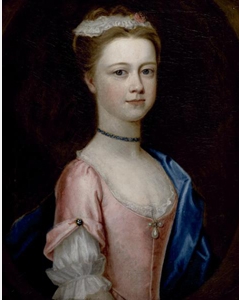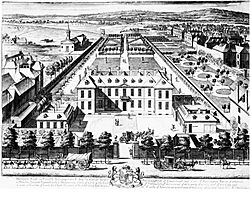Dorothy Boyle, Countess of Burlington facts for kids
Quick facts for kids
The Right Honourable
The Countess of Burlington
|
|
|---|---|

Michael Dahl, Lady Dorothy Savile, Countess of Burlington and Countess of Cork, oil painting, 1720, Hardwick Hall, National Trust.
|
|
| Born |
Dorothy Savile
13 September 1699 |
| Died | 21 September 1758 (aged 59) |
| Nationality | English |
| Education | |
| Known for | Caricatures and portraits |
| Spouse(s) | |
| Children |
|
| Parents |
|
Dorothy Boyle, Countess of Burlington and Countess of Cork (born Savile; 13 September 1699 – 21 September 1758) was a British noblewoman and a talented artist. She was known for her caricatures and portraits. Dorothy Boyle also supported many artists and musicians of her time.
She was a Lady of the Bedchamber for Queen Caroline. A famous street in London, Savile Row, was named after her family name, Savile.
Contents
Early Life
Dorothy Savile was born on September 13, 1699. Her father was William Savile, 2nd Marquess of Halifax. Her mother was Mary Finch. Dorothy was one of the people who would inherit her father's property.
She had a sister named Mary. Dorothy also had a half-sister, Anne, from her father's first marriage.
A Talented Artist

Dorothy Boyle loved art and learned to draw and paint. She studied with William Kent, who was also a designer and gardener. Kent lived with Dorothy and her family for 30 years. They even painted portraits of each other!
By the mid-1720s, she also learned from Joseph Goupy. She started with pastels and then moved on to oil painting. She might have even had lessons from Charles Jervas, who was the King's portrait painter.
Lady Boyle was very good at drawing caricatures, which are funny drawings that exaggerate features. She was also quick at making portraits. A famous writer, Horace Walpole, said she was excellent at capturing how people looked.
She painted many pictures of her daughters. At Chatsworth House, there are 24 of her artworks. These include oil paintings and pastel studies of her daughters. One of her sketches shows a woman playing music for fun, with a dog and a cat nearby. She also sketched her friend, the poet Alexander Pope.
Supporting the Arts
Dorothy Boyle was a generous supporter of artists and musicians. She helped people like the famous actor David Garrick and the composer George Frideric Handel.
She was one of the people who signed a petition in 1735. This petition asked King George II to create the Foundling Hospital. This hospital was a charity for children who had been abandoned. Her husband, Richard Boyle, 3rd Earl of Burlington, later became a governor of this charity.
Dorothy Boyle also welcomed the dancer Eva Marie Veigel into her home, Burlington House, when she first came to England. Eva Marie later married David Garrick.
Savile Row
Dorothy Boyle helped plan a new street in London for fancy houses. In 1733, newspapers reported that new buildings would be built on Savile Street in Mayfair, London.
This project was named Savile Row after Lady Dorothy Boyle's maiden name, Savile. By the late 1700s, Savile Row became famous for its high-quality tailor shops.
Marriage and Family Life
Dorothy Savile married Richard Boyle, 3rd Earl of Burlington, on March 21, 1721. She brought a large dowry (money or property given by the bride's family) to the marriage. They both loved theatre and music. She enjoyed opera and was a big fan of the writer John Gay.
Soon after they married, Dorothy and Richard started updating Chiswick House and its gardens. They also lived at Londesborough and Burlington House in London.
Dorothy had three daughters: Dorothy (born 1724), Julianna (born 1727), and Charlotte (born 1731). A painter named Jean-Baptiste van Loo painted a family portrait of Dorothy, her husband, and their three daughters in 1739.
Her eldest daughter, Dorothy, married in 1741 but sadly died of smallpox in 1742. Her youngest daughter, Charlotte, married William Cavendish, 4th Duke of Devonshire in 1748. Charlotte also died of smallpox in 1754. Charlotte passed on her mother's artworks and letters to her own children.
The Countess of Burlington passed away on September 21, 1758, when she was 59 years old.
Images for kids
-
Dorothy Savile, Lady Dorothy Boyle and Her Sister Lady Charlotte Boyle. This painting is at Hardwick Hall.




